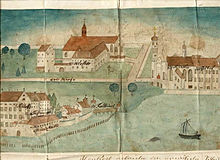Anton III from Montfort
Anton III von Montfort (* 1670 ; † 1733 ) was ruling Count of Tettnang and Langenargen from 1686 (until 1692 still under the tutelage of his uncle Anton II ) . Because of the county's high debt burden, he prematurely handed over the affairs of state to his son Count Ernst in 1727 .
Live and act
Anton III von Montfort was the son and successor of Johann X. , who fell from his horse and died. Because of his excessive love of art and his penchant for splendor and extravagance, Johann Nepomuk Vanotti , the biographer of the Montfort family, called him the “real enemy and corrupter of his family”, although the descent of the count's house had started much earlier.
In 1693 or 1694 in Dillingen he married Anna Maria (1664–1733), a daughter of Maximilian von Thun and Hohenstein , Fideikommissherrn zu Tetschen on the Elbe. Anton had two sons and a daughter with her. Together with his wife, he founded a monastery in Langenargen for the Capuchin Order . In 1699 he got a job at the Salzburg archbishop's court from Anna Maria's uncle Johann Ernst Graf von Thun and Hohenstein . The count family moved to Salzburg, where they acquired the Montforter Hof and leased the income from their heavily indebted county to the chief magistrate Johann Baptist Fritz in return for an annual payment of 9,000 guilders and the obligation to reduce the debt burden.
After the Archbishop's death, the family returned to their county. In view of the modest conditions in comparison with the luxury of the Salzburg court, Count Anton started a comprehensive construction project. With this he wanted to upgrade his county according to his class claims. Together with Christoph Gessinger, he ordered the master builder of the New Meersburg Castle of the Prince-Bishop of Constance to build the New Castle in Tettnang in his residence town of Tettnang between 1712 and 1720 .
After he had already taken the first step of upgrading his secondary residence Langenargen with the settlement of the monastery, he had a new city center built in the axis between Argen Castle and the monastery. For this purpose, the new building of the Hospital of the Holy Spirit in Langenargen was realized parallel to the construction work on the palace in 1716–1718. Immediately afterwards from 1718 to 1722 he had the new parish church of St. Martin von Langenargen built after the old parish and cemetery church of St. Martin was demolished . For their originally planned two towers, however, the money was initially lacking, so that only his successor Count Ernst was able to build only one of the two towers and the representative rectory. In 1719 Count Anton tried in vain to have the remains of the supposed ancestor saint John of Cyprus transferred to the parish church in Langenargen via the emperor . With this overall project, Count Anton sought to raise his rank to the imperial prince's rank , which he and his family were not allowed to do, as the counts no longer had the necessary political, but especially economic, influence.
Coin counterfeiting scandal
The Counts of Montfort-Tettnang were accused of forging coins in 1722. They are said to have minted large quantities of the so-called "Konstanzer Ratsschilling". The traces undoubtedly led to the Langenargen mint, but to the chagrin of the people of Constance, the counts could not be held accountable because they had leased the mint. After 1726, Anton III. the coin production continued, whereby the value of the money fell drastically because of the huge quantities (approx. 60 million Kreuzer coins in seven years) and the inferior quality. As a consequence, money traffic in southern Germany collapsed.
Succession
From 1727 onwards, Anton III. brought his son Count Ernst to join the government. In 1728 he and his wife moved from the Montfort rulers in the Lake Constance region to Salzburg, where they both died in 1733, where they both died in 1733. In 1733, his son Ernst took over government affairs in the county, which was on the brink of bankruptcy due to the enormous increase in debt.
literature
- Andreas Arzet: Montfortic ceder or family tree: origin and tradition, stories and deeds, country and people of the Counts of Montfort . Arranged by Julian Schulz. Edited by Stefan Feucht, Elmar L. Kuhn and Alois Niederstätter. Eggingen 2018 (= Documenta suevica 26), ISBN 3-86142-605-6 , p. 814.
Web links
- Support group Heimatkunde Tettnang: Counts of Montfort
- sueddeutscher-barock.ch about Anton III. : pdf
References and comments
- ^ A b Heinz Wember: The Genealogy (Genealogy) of Montfort: Anton II. D. J. v. Montfort. ( Memento from December 27, 2014 in the Internet Archive )
- ↑ a b c Förderkreis Heimatkunde Tettnang: Counts of Montfort.
- ↑ The old manor house Montfort Castle (also called Golser Hof or Montforter Schlösschen) is located in the south of the Salzburg district of Morzg on the southern flank of the Morzger hill.
| predecessor | Office | successor |
|---|---|---|
|
Anton II of Montfort (guardian) |
Mr. zu Tettnang and Argen 1692–1727 / 33 |
Ernst von Montfort |
| personal data | |
|---|---|
| SURNAME | Montfort, Anton III. from |
| ALTERNATIVE NAMES | Anton III |
| BRIEF DESCRIPTION | German nobleman, ruling count of the county of Monfort |
| DATE OF BIRTH | 1670 |
| DATE OF DEATH | 1733 |

